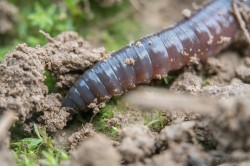Press Release, 15. January 2021
Measuring the belowground world
Researchers call for greater consideration of soil biodiversity and functions in international conservation strategies
A quarter of all known species live in the soil. Life above ground depends on the soil and its countless inhabitants. Yet, global strategies to protect biodiversity have so far paid little attention to this habitat. In the journal Science, an international team of researchers, including scientists from the UFZ, calls for greater consideration of soils in the renegotiation of international biodiversity strategies. Their relevance must be recognised far beyond agriculture. In order to make the status and performance of soils more visible, the researchers explain their plan for systematic recording based on common global standards.

Photo: Valentin Gutekunst

Photo: Andy Murray
If you asked people which group of animals is the most abundant on earth, hardly anyone would know the right answer. Ants? Fish? No, and not humans either. The answer is nematodes, also known as roundworms. Four out of five animals on earth belong to this group, and the reason hardly anyone is aware of the fact is that they live underground, invisible to us. Together with thousands of other soil organisms, they quietly, discreetly and constantly perform enormously important services for the world above them.
The soil is one of the most species-rich habitats in existence. Living under one square meter of healthy soil you can find up to 1.5 kilograms of organisms: among others, roundworms, earthworms, springtails, mites and insect larvae. There is also a multitude of microorganisms including bacteria, protists and fungi. They eat and transform living and dead animal and plant material into nutrients which become the basis for growth and new life. Without soil organisms, no plants would be able to grow and no humans could live.
It is therefore all the more astonishing that soils have so far hardly featured in international strategies for protecting biodiversity. The authors of the new article in Science see this as a big problem: "If we do not protect soils for the next generations, aboveground biodiversity and food production cannot be guaranteed either." Their appeal goes out to the 196 nations who are currently negotiating a new strategy to protect biodiversity within the framework of the UN Convention on Biological Diversity (CBD).
Soil biodiversity helps or punishes us depending on how we manage its habitat," explains one of the co-authors François Buscot, who heads the Department of Soil Ecology at the Helmholtz Centre for Environmental Research (UFZ). Average temperatures increase throw soil organism communities out of balance, benefiting pathogens in our crops. Harmful fungi and bacteria are also favored by intensive agriculture and, for example, by the accumulation of plastics in the soil. But if we know how to use our soils gently, their organisms will help us to fight global warming by sequestering more carbon from the atmosphere in the soil.
Healthy soils are becoming increasingly rare. They suffer the burden of intensive cultivation with heavy machinery, fertilisers and pesticides, are compacted, built over or are lost due to wind and water erosion. Global warming is putting them under additional pressure. According to the German Heinrich Böll Foundation, around 24 billion tons of fertile soil are lost worldwide every year. As a result, the soils’ wide variety of services such as water purification and protection against plant diseases gradually decline. In addition, soils are the most important carbon reservoir on earth and therefore help slow global climate warming.
According to the researchers, these services are given far too little attention in the political debate. "Up to now, soil conservation has been mostly reduced to the impacts related to soil erosion and its importance for agriculture," said first author Dr Carlos Guerra (iDiv, MLU). "It's about time that soil conservation policies consider the protection of soil organisms and ecosystem functions more than just for food production and other productive systems. Soil biodiversity monitoring and conservation can support the achievement and tracking of many sustainability goals, targeting areas such as climate, food and biodiversity protection."
"Protection measures have so far mainly focused on life above ground, for example in the designation of protected areas," said senior author Dr Diana Wall from Colorado State University. However, since these do not necessarily benefit underground biodiversity, the specific needs of the biotic communities in the soil have to be taken into account.
In order to be able to decide which regions of the world are particularly in need of protection, and which protective measures are appropriate, sufficient information must be available on the status and trends of biodiversity in soils. Since this has not been the case so far, the researchers launched the Soil BON monitoring network. "We want to move biodiversity in soils into the focus of conservation efforts. To do this, we must provide policymakers with the necessary information to support decision-making," said senior author Prof Nico Eisenhauer, research group leader at iDiv and Leipzig University. "Soil BON will produce and support the production of the relevant data to achieve this goal."
Soil BON is designed to help collect comparable soil data across the board and over long time periods. Standardised rules are necessary worldwide to determine what should be recorded and how. The researchers propose a holistic approach for this based on the so-called Essential Biodiversity Variables (EBVs). EBVs are key priority variables for measuring biodiversity and its change. In the case of Soil BON, these include parameters such as soil respiration, soil enzyme activity, nutrient turnover and genetic diversity. Indicators are derived from the EBVs, which serve as a basis for decisions on the assessment and protection priorities of soils.
According to the researchers, their proposed monitoring and indicator system will enable the worldwide condition of soils and their capacity to function to be recorded efficiently and monitored long term. They emphasise that it also serves as an important early warning system; with its help, it will be possible to identify, at an early stage, whether existing nature conservation goals can be achieved with current measures.
This research was, among others, supported by the Deutsche Forschungsgemeinschaft (DFG; FZT-118).
Publication:
Carlos A. Guerra, Richard D. Bardgett, Lucrezia Caon, Thomas W. Crowther, Manuel Delgado-Baquerizo, Luca Montanarella, Laetitia M. Navarro, Alberto Orgiazzi, Brajesh K. Singh, Leho Tedersoo, Ronald Vargas-Rojas, Maria J. I. Briones, François Buscot, Erin K. Cameron, Simone Cesarz, Antonis Chatzinotas, Don A. Cowan, Ika Djukic, Johan van den Hoogen, Anika Lehmann, Fernando T. Maestre, César Marín, Thomas Reitz, Matthias C. Rillig, Linnea C. Smith, Franciska T. de Vries, Alexandra Weigelt, Nico Eisenhauer & Diana H. Wall (2020): Tracking, targeting, and conserving soil biodiversity - A monitoring and indicator system can inform policy, Science, DOI: 10.1126/science.abd7926 https://science.sciencemag.org/content/371/6526/239
Further information
Prof. Dr. François Buscot
Head of the UFZ Department soil Ecolgy
francois.buscot@ufz.de
Prof. Dr. Nico Eisenhauer
iDiv / Uni Leipzig
nico.eisenhauer@idiv.de
Dr. Carlos Guerra
iDiv / MLU Halle-Wittenberg
carlos.guerra@idiv.de
UFZ press office
Susanne Hufe
Phone: +49 341 6025-1630
presse@ufz.de
In the Helmholtz Centre for Environmental Research (UFZ), scientists conduct research into the causes and consequences of far-reaching environmental changes. Their areas of study cover water resources, ecosystems of the future, environmental technologies and biotechnologies, the effects of chemicals in the environment, modelling and social-scientific issues. The UFZ employs more than 1,100 staff at its sites in Leipzig, Halle and Magdeburg. It is funded by the Federal Government, Saxony and Saxony-Anhalt.
www.ufz.deThe Helmholtz Association contributes to solving major challenges facing society, science and the economy with top scientific achievements in six research fields: Energy; Earth and Environment; Health; Key Technologies; Matter; and Aeronautics, Space and Transport. With some 39,000 employees in 19 research centres, the Helmholtz Association is Germany’s largest scientific organisation.
www.helmholtz.de